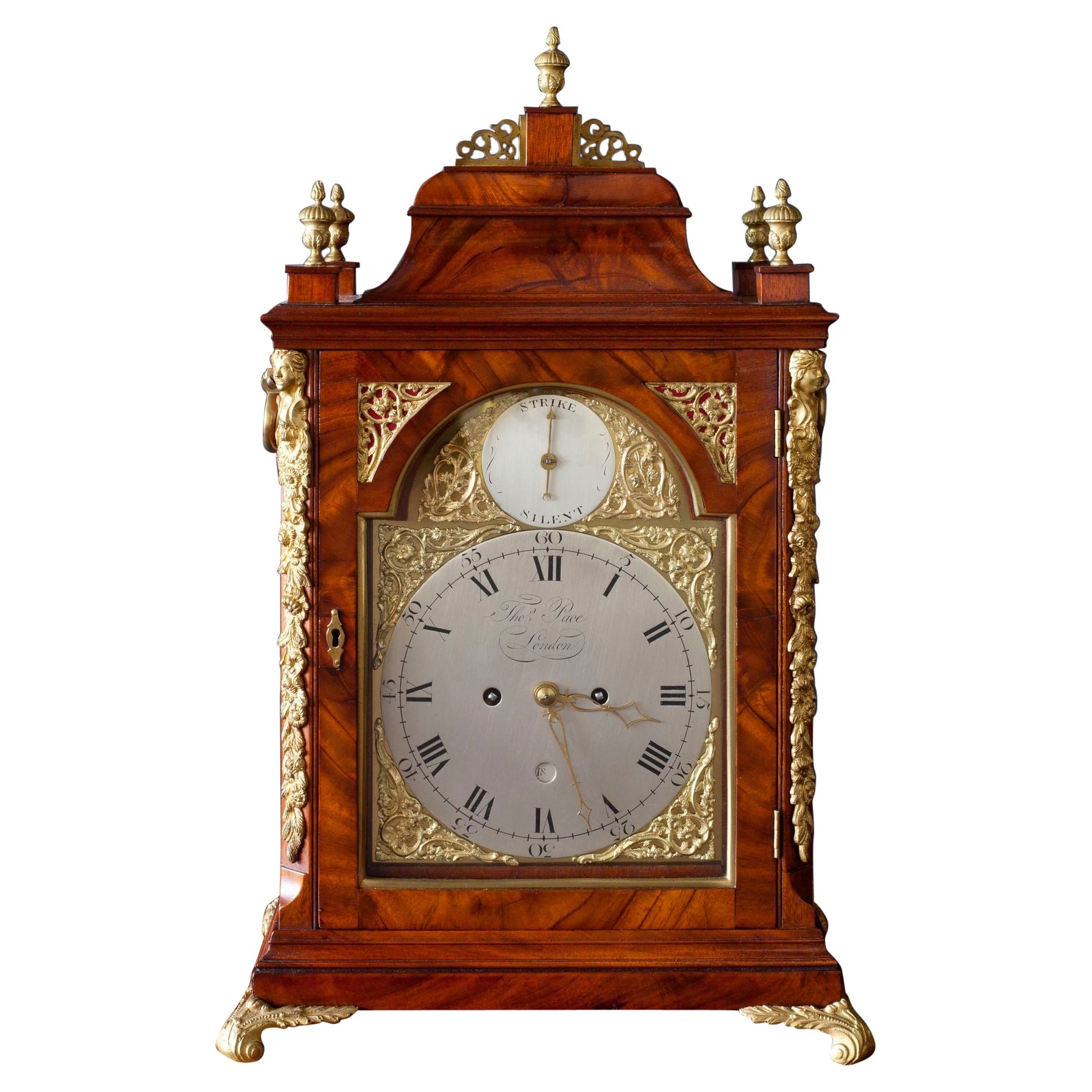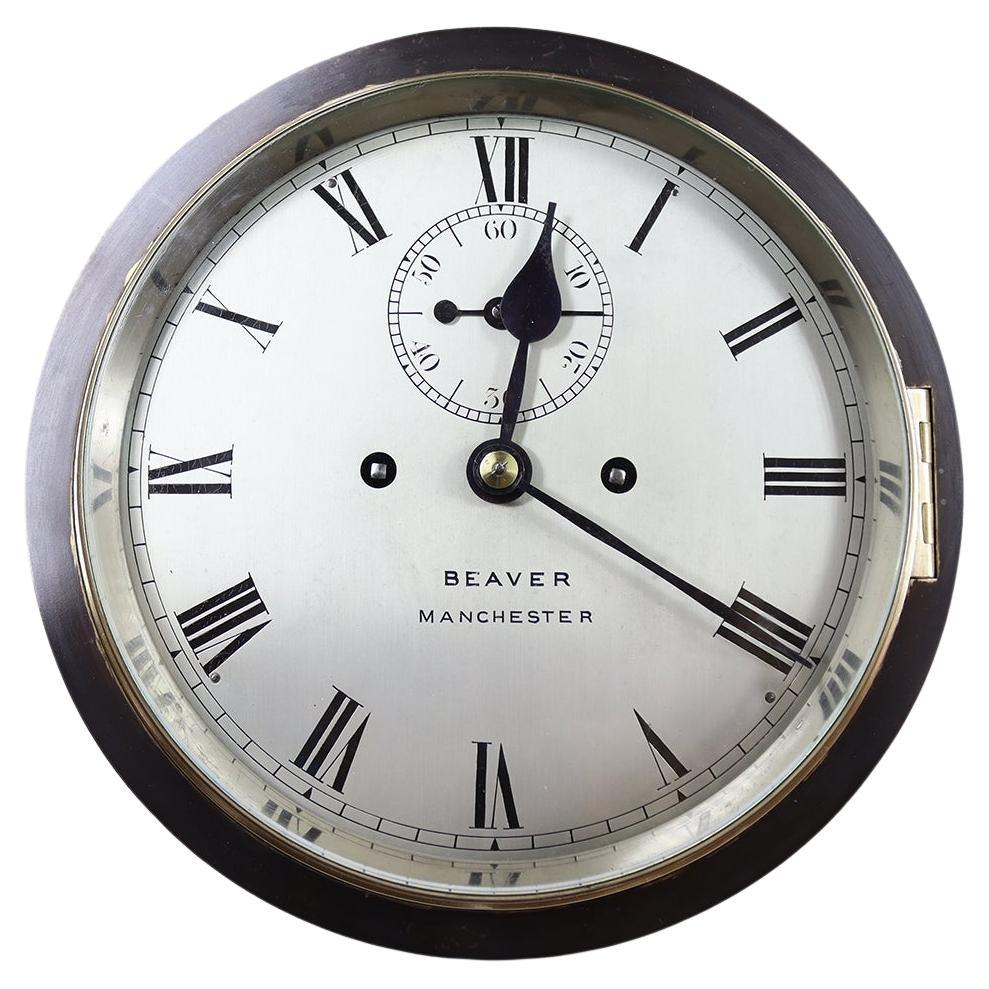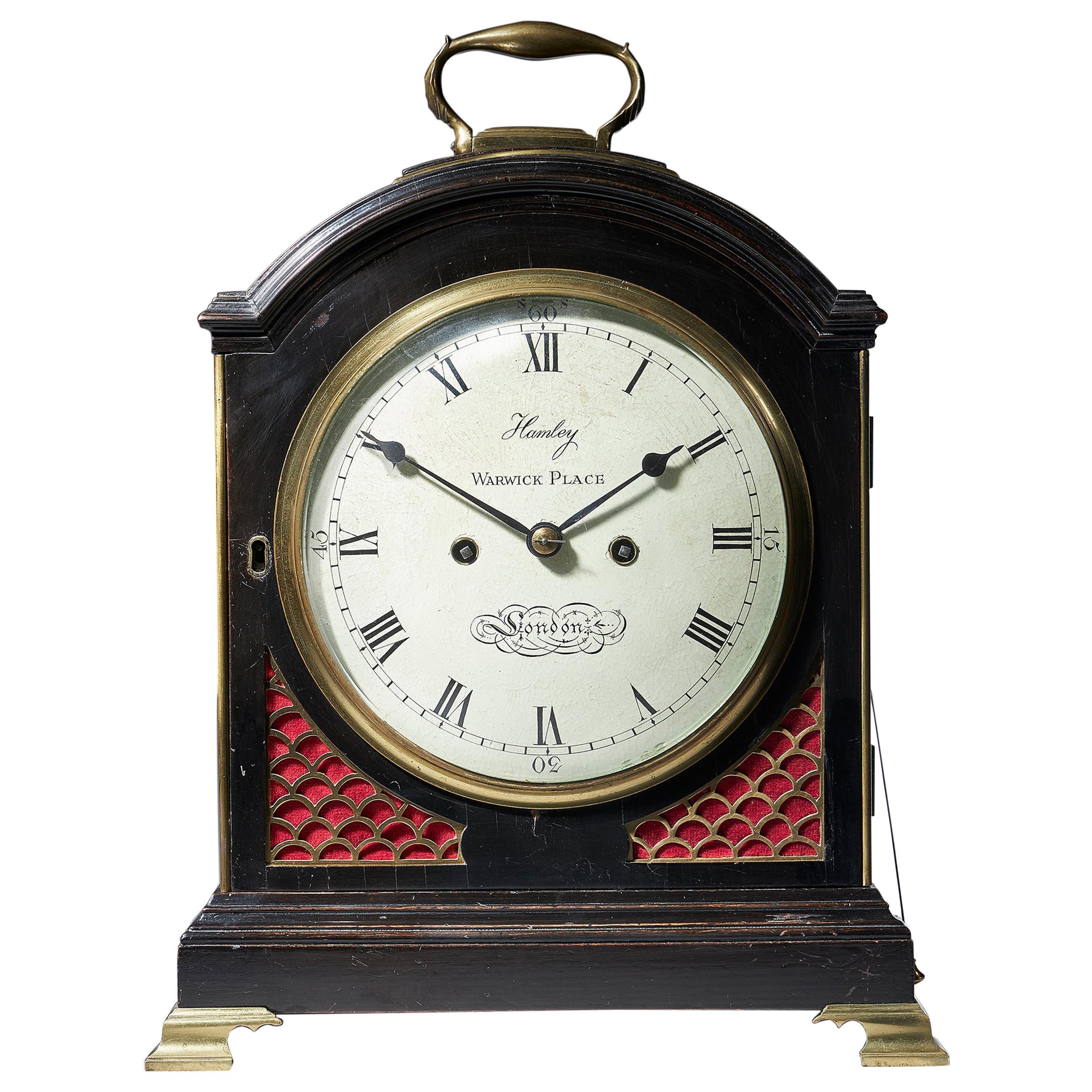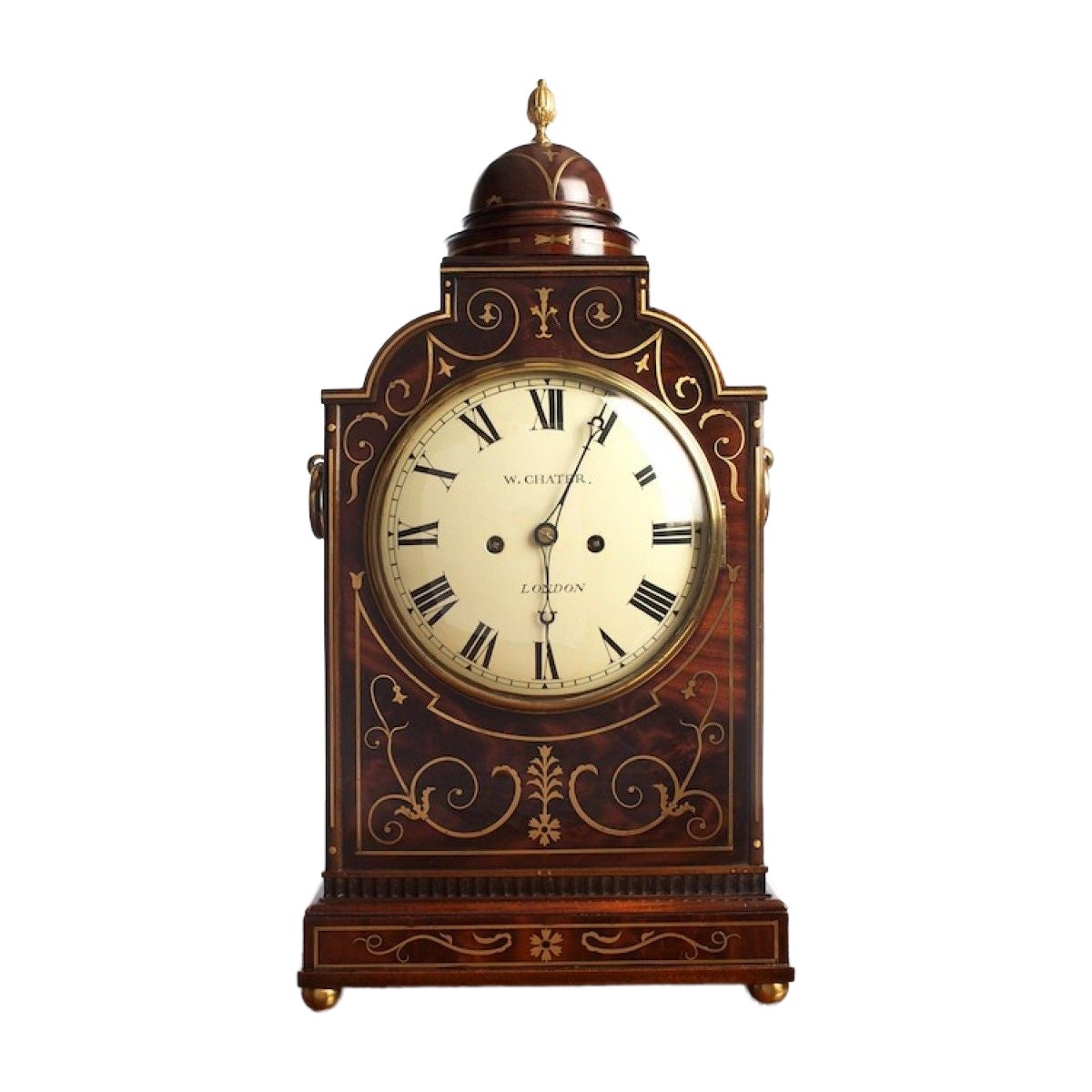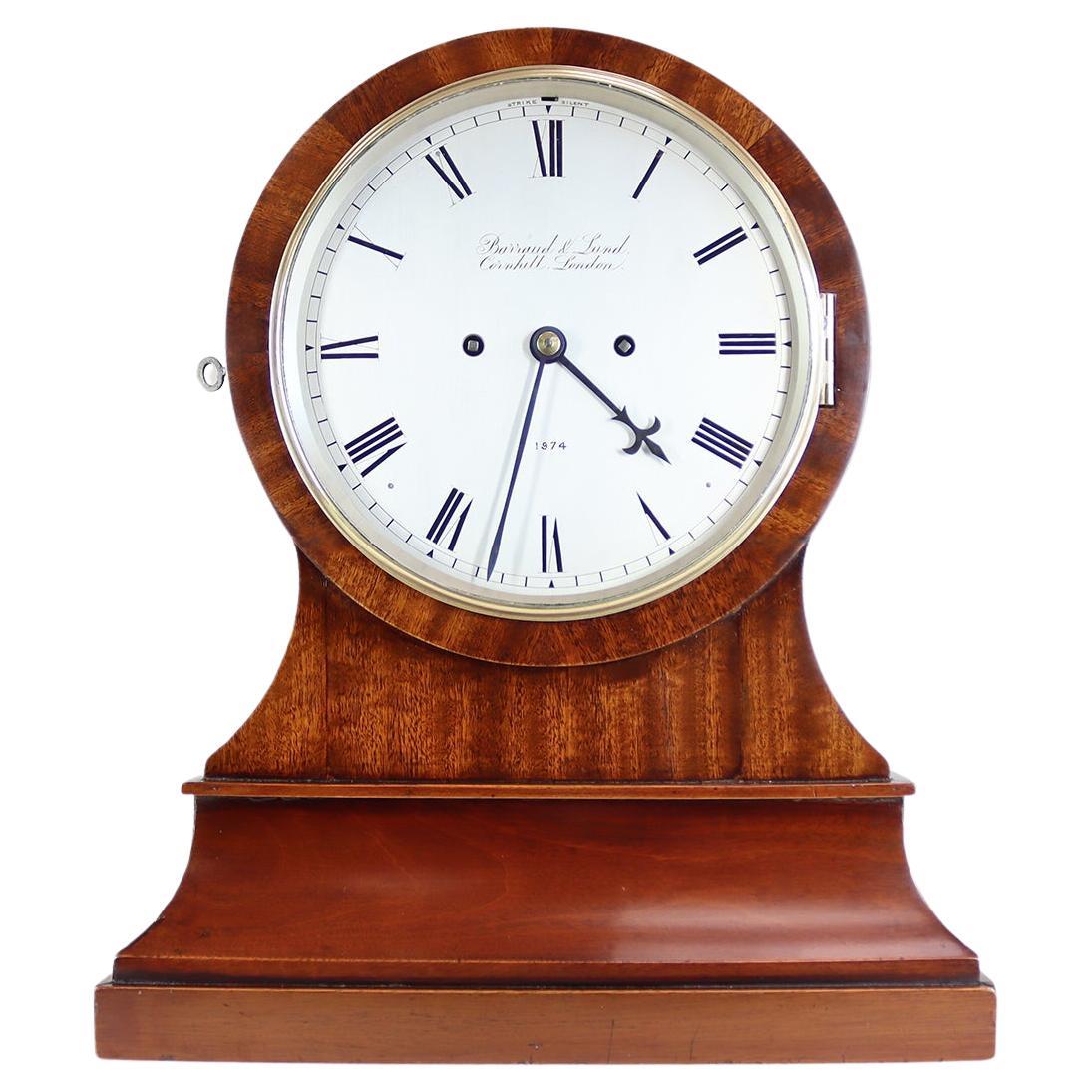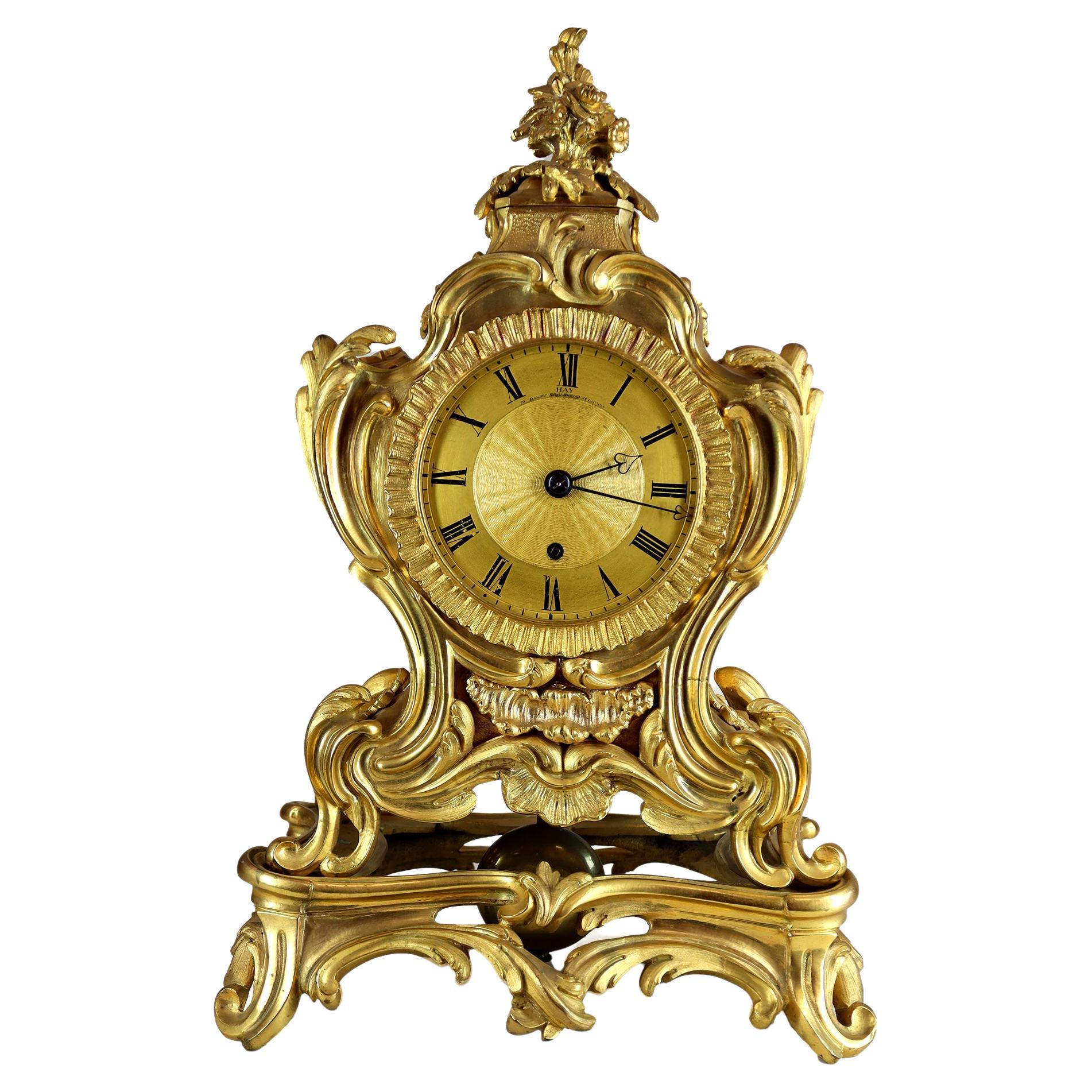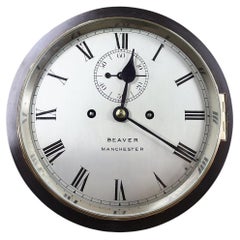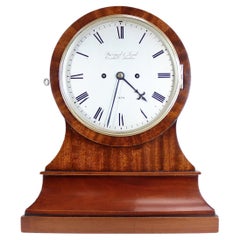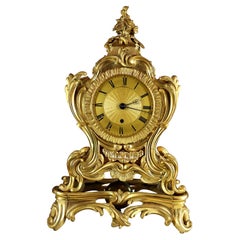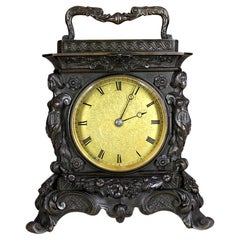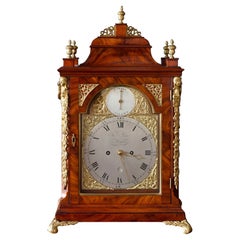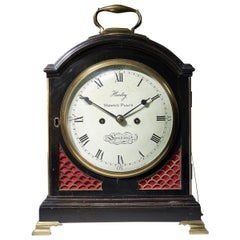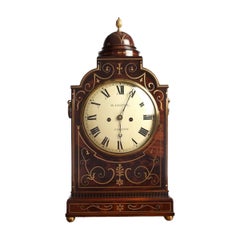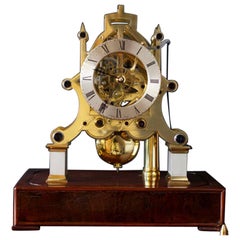Items Similar to John Leroux, London. Twin Fusee Balloon Clock
Want more images or videos?
Request additional images or videos from the seller
1 of 13
John Leroux, London. Twin Fusee Balloon Clock
About the Item
An 18th century balloon shaped bracket or table clock by John Leroux of Charing Cross, dating from circa 1790. The waisted case surmounted by a brass pineapple finial over a drum housing the movement. The dial is behind a hinged convex glazed cast brass bezel to front and brass carrying handles to sides, over hipped concave-sided section forming the base. The front has an applied mount of a sunburst mask, the rear with keyhole shaped door incorporating fine scroll-pierced sound fret set within the frame of the case, on generous cavetto moulded skirt base incorporating break-arch recess to apron and with ogee bracket feet.
The five knopped pillar twin fusee bell striking movement with rounded angles to the rectangular plates and anchor escapement regulated by a long bob pendulum with an effective length of approximately 11.5 inches, the backplate signed J. Leroux, London to centre, the 7 inch circular single sheet silvered brass Roman numeral dial signed Leroux, Charing Cross to centre, with fine pierced steel hands and Arabic five minutes to outer track.
An identical clock is illustrated in English Bracket and Mantel Clocks by Andrew Nicholls, 1981 p108 fig 46.
John Leroux is recorded in Baillie, G.H. Watchmakers & Clockmakers of the World as an 'eminent maker' who worked from Charing Cross 1781-1808. He was particularly well known as being one of the first makers to incorporate the lever escapement within his watches and was succeeded by James Rigby. A similar clock by Leroux, is illustrated in Barder, Richard C.R. The Georgian Bracket Clock 1714-1830 page 147 (plate IV/95).
Leroux is also mentioned in English Domestic Clocks By Herbert Cescinsky and Malcolm Webster Illustration 357 p314 showing another balloon clock of the same form.
Examples of Leroux’s work can be found in the collections of the British Museum, The Science Museum, John Soanes Museum and the Welcome Collection.
Previously the property of Deutsche Bank; This clock was retailed by Percy Webster, there is one of his distinctive engraved plaques inside the case. Percy Webster, was a notable antiques dealer and clockmaker who operated during the late Nineteenth and early Twentieth Centuries and is considered by some to be the first notable authority on antiquarian clocks and later took up the position of Master of the Worshipful Company of Clockmakers. His son, who followed his Father into business was equally respected and was responsible alongside Herbert Cescinsky for producing the book that became, and to some extend still is, the clock collector’s bible, “English Domestic Clocks”. We have included and image of Webster’s showroom, that tantalisingly has a balloon clock of the same form visible, proving that this superb clock was of considered to be of the highest quality by Webster.
This clock comes with our 2 year guarantee.
- Creator:John Leroux (Clockmaker)
- Dimensions:Height: 13.78 in (35 cm)Width: 11.23 in (28.5 cm)Depth: 7.29 in (18.5 cm)
- Style:George III (Of the Period)
- Materials and Techniques:
- Place of Origin:
- Period:
- Date of Manufacture:1790
- Condition:
- Seller Location:Amersham, GB
- Reference Number:Seller: 1571stDibs: LU9135236384322
About the Seller
No Reviews Yet
Vetted Professional Seller
Every seller passes strict standards for authenticity and reliability
1stDibs seller since 2023
Typical response time: 1 to 2 days
- ShippingRetrieving quote...Shipping from: Amersham, United Kingdom
- Return Policy
Authenticity Guarantee
In the unlikely event there’s an issue with an item’s authenticity, contact us within 1 year for a full refund. DetailsMoney-Back Guarantee
If your item is not as described, is damaged in transit, or does not arrive, contact us within 7 days for a full refund. Details24-Hour Cancellation
You have a 24-hour grace period in which to reconsider your purchase, with no questions asked.Vetted Professional Sellers
Our world-class sellers must adhere to strict standards for service and quality, maintaining the integrity of our listings.Price-Match Guarantee
If you find that a seller listed the same item for a lower price elsewhere, we’ll match it.Trusted Global Delivery
Our best-in-class carrier network provides specialized shipping options worldwide, including custom delivery.More From This Seller
View AllA Twin Fusee Ships Striking Bulkhead Clock
Located in Amersham, GB
A fine ship’s bell bulkhead clock striking the ‘Dog Watches’ Sequence. This eight day twin fusee clock is a rare example of a ships striking clock marking ...
Category
Antique 1850s English Industrial Wall Clocks
Materials
Silver, Brass, Bronze, Steel
Twin Fusee Bracket Clock By Barraud And Lund
Located in Amersham, GB
A striking drum head bracket clock by Barraud and Lund of exceptional quality. The case is made of quarter sawn mahogany with a beautifully crisp silv...
Category
Antique Mid-19th Century English Victorian Mantel Clocks
Materials
Brass
Single Fusee Mantel clock by Hay London
By HAY
Located in Amersham, GB
An unusual english single fusee mantel clock in a Louis XV style rocaille ormolu case in the french taste. The eight day fusee movement is of superb quality with a pendulum descendin...
Category
Antique Early 19th Century British Rococo Mantel Clocks
Materials
Bronze
A Unique Twin Fusee English Carriage Clock by James Moore French
By Santiago James Moore French
Located in Amersham, GB
A one of a kind english twin fusee carriage clock by James Moore French. The eight day movement has a large English jewelled level escapement with compensated bimetallic balance. The movement is wound and set through a round glazed door at the back and can be regulated from the outside as the fast/slow arm extends through the back of the case with rack striking the hour and half hour on blued steel gong with trip repeat.
The gilt dial is signed as is th back plate of the movement, the centre of the dial is engraved with foliate scroll work with a roman chapter and breguet style moon hands.
The unusual case of case bronze in a rococo revival style is finely chased with fluted sides flanked by Cariatids with a swag of fruit and flowers strung between them, th handle is formed of two dolphins.
James Moore French was born in 1781 in County Antrim, Ireland. He was the son of Dr Hugh French and Sarah (née Arundel) French who married his father in 1763 and died in 1783, two years after James’s birth. In 1784, the year after Sarah’s death, Dr Hugh French married a widow named Judith Woodward who was to raise the young James French as her own, alongside his own and his half siblings. As a young man, James French moved from Ireland to London, where he worked with a relative, Peter Moore...
Category
Antique 19th Century English Rococo Revival Carriage Clocks and Travel C...
Materials
Brass, Bronze, Steel
Miniature Single Fusee Bracket Clock By William Johnston, Strand, London
By Johnson
Located in Amersham, GB
An extremely small single fusee bracket clock in a scalloped mahogany case. The eight day movement having a half deadbeat escapement with a T bar pendulum with hold fast, is beautifu...
Category
Antique 1830s English William IV Table Clocks and Desk Clocks
Materials
Brass, Ormolu
Goliath Single Fusee Dial Clock or Station Clock
Located in Amersham, GB
This giant single fusee dial clock would have been made for a public space like a railway station. Made By Swinden and Sons of Birmingham, it has a su...
Category
Antique 1880s English Late Victorian Wall Clocks
Materials
Brass, Steel
You May Also Like
George III Mahogany Twin Fusee Verge Bracket Clock by Thomas Pace, London
By Thomas Pace
Located in Norwich, GB
George III Bell Top Bracket Clock
Fine flame mahogany case with ormolu mounts and ormolu caryatids standing on bracket feet. Silvered dial with subsidiary dial for strike/silent,...
Category
Antique 1780s English George III Table Clocks and Desk Clocks
Materials
Mahogany
George III Ebonized Eight-Day Twin Fusee Table Clock by O. Hamley
Located in Oxfordshire, United Kingdom
A lovely late George III single pad ebonized eight-day, twin fusee table clock with original verge escapement and rack striking by O. Hamley, circa 1800-1815.
The moulded single pad ebonized domed top case with original carrying handle is raised on all four of its original ogee bracket feet onto a detailed base moulding. Gilt-brass sound frets adorn the sides and front in a 'fish scale' pattern backed with bright burgundy silk.
The enameled white dial displays Roman numerals, minute and quarter-hour markers housed inside a gilt-brass bezel and domed glass, signed Hamley, Warwick Place, London.
The clock features a strike/silent switch on the front dial and a repeat to the right-hand-side. The backplate has border engraving and a short pendulum.
Date: 1800-1815
O. Hamley is recorded in Loomes (2006) as being active, circa 1811. He also worked at Bedford Row...
Category
Antique Early 1800s English George III Table Clocks and Desk Clocks
Materials
Fruitwood
George III Mahogany English Fusee Bracket Clock by William Chater, London
Located in Norwich, GB
George III Bracket Clock.
Stunning mahogany case with Cupola top surmounted by a ‘pineapple’ finial, profusely inlaid with brass, fishscal...
Category
Antique 1810s English George III Table Clocks and Desk Clocks
Materials
Mahogany
William IV Double Fusee Skeleton Clock by A. Stewart, London
Located in Norwich, GB
A William IV Skeleton clock of fine quality with two massive scroll plates sitting on rectangular, silvered plinths and standing on a mahogany base with block feet.
Eight day doubl...
Category
Antique 1830s English William IV Mantel Clocks
Materials
Brass
Regency Mahogany English Fusee Bracket Clock by Memmes, London
Located in Norwich, GB
Regency bracket clock in an arch top case with brass inlay and dentil moulding, side carrying handles and standing on four brass ball feet.
Painted dial with Roman numerals and original spade hands signed ‘Memess, Trafalgar Square, London’.
Glazed rear door to the fine quality eight day single fuse movement with arch shaped plates and ‘regulating’ pendulum. C.1820.
‘Watchmakers and clockmakers of the world’ by Brian Loomes...
Category
Antique 1820s English Early Victorian Table Clocks and Desk Clocks
Materials
Mahogany
18th Century Thomas Moss, London, Fusee Bracket Clock in Mahogany Case
By Thomas Moss
Located in Milford, NH
Thomas Moss Fusee bracket clock, London, brass silvered dial signed by the maker. "Thomas Moss, London." A mahogany veneered case with brass trim and bracket top. The movement is an ...
Category
Antique 18th Century English Georgian Table Clocks and Desk Clocks
Materials
Brass
